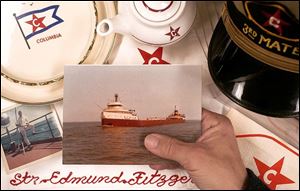
Library remembers sinking of Fitzgerald
3/21/2005
The exhibit at the Way Public Library in Perrysburg features linens and china from the 729-foot freighter and postcards. The ship was caught in a storm in November, 1975, and sank in Lake Superior. The freighter went down in 530 feet of water with the crew of 29.
Larry Elliott hasn't forgotten the first time he saw high resolution pictures, from a remotely controlled camera, of the wreckage of the steamship Edmund Fitzgerald 16 years ago. Even more impressive was viewing the famous shipwreck in person five years later.
"It's a pretty sobering feeling," said Mr. Elliott, who was part of a team that visited "The Big Fitz" 530 feet below Lake Superior's surface in a miniature submarine in 1994 and 1995. "Seeing it with your own eyes, you have great respect for the men who died and for the site itself."
Mr. Elliott and a fellow dive team member, Jene Quirin, will give talks Wednesday at Perrysburg's Way Public Library about their experiences visiting the shipwreck memorialized by Canadian folk singer Gordon Lightfoot. All space for a 7 p.m. presentation already has been reserved, but no advance registration is required for a shorter version set for 4 p.m. for an after-school audience.
Mr. Quirin and Mr. Elliott, neighbors in Frankenmuth, Mich., are directors of the Great Lakes Shipwreck Historical Society.
Library staff also have compiled a videotape of reminiscences from relatives of some of the 29 crew who went down with the ship and from people who had been assigned to the Fitzgerald previously. Seven crewmen, including ship captain Ernest McSorley of Ottawa Hills, were from northwestern Ohio.
Excerpts from the tape will be shown throughout the day Wednesday at the library. The tape will become part of a collection of oral histories that Way has been making, but is the first to report how a specific event is remembered by the community rather than recording general thoughts about life in Perrysburg, said Mary Meyer, the library's program coordinator.
"I was really surprised to find so many people who have connections to shipping, and directly or indirectly to the Edmund Fitzgerald," Ms. Meyer said.
The Fitzgerald program was suggested to the library by Historic Perrysburg, she added.
The largest freighter on the Great Lakes when it was launched in 1958, the 729-foot Fitzgerald became the biggest to sink when it went down without a distress call off Whitefish Point, Mich., during a severe storm on Nov. 10, 1975. The last communication from Captain McSorley, radioed to the S.S. Arthur M. Anderson shortly after 7 p.m., reported: "We are holding our own."
Mr. Lightfoot wrote his ballad, "The Wreck of the Edmund Fitzgerald," after reading newspaper reports of the Fitz's sinking and the 29 times that the Rev. Richard Ingalls, tolled the bell at the Mariners' Church in Detroit after hearing of the boat's disappearance. The song helped rank the Fitzgerald's sinking among the best known in North American marine history, perhaps second to only the Titanic.
Part of an exhibit of Fitzgerald memorabilia is already on display in the library's lower level, including china and linens from the vessel, and postcards and numerous photographs, the latter highlighted by a view of the vessel being unloaded at the Torco Dock in Oregon. A scale model of the ship and several large paintings are to be added to the exhibit on Tuesday, in time for viewing in conjunction with the appearance by Mr. Elliott and Mr. Quirin.
"Once you get down and see it up close, it's quite an eye-opening experience. It's setting there just like it would have when it sank," said Mr. Quirin.
The 1995 dive team retrieved the Fitzgerald's 200-pound bronze bell, swapping for it a duplicate that was identical except for the engraving of the lost sailors' names.
Along with Captain McSorley, the northwest Ohioans lost in the sinking were Thomas E. Edwards, second assistant engineer, of Oregon; Russell G. Haskell, second assistant engineer, of Millbury; Eugene W. O'Brien, wheelsman, of Perrysburg Township; Robert C. Rafferty, steward, of Toledo; William J. Spengler, watchman, of Toledo; and Ralph G. Walton, oiler, of Fremont.
While some relatives objected to the dives, the bell was retrieved with the support of many others who wanted something from the Fitzgerald to serve as a memorial. It has been placed on display at the Great Lakes Shipwreck Museum in Whitefish Point.
"It's a memorial to the Fitzgerald crew, and to all sailors who died on the Great Lakes," Mr. Elliott said, remarking later: "We've been very fortunate that there hasn't been another catastrophic loss on the Great Lakes."
And Thomas Walton, the Fremont oiler's nephew who himself sailed on the Fitzgerald for four months in 1964 but chose another profession and now is editor of The Blade, said the pictures that the divers brought back both amaze and haunt him.
"I see passageways I went through, ladders I climbed," Mr. Walton said. The twisted and torn steel testifies to "the awful forces that brought that ship down."
Mr. Walton will interview both men for a presentation of The Editors television show Friday at 8:30 p.m. on WGTE Channel 30 and at 12:30 p.m. Sunday on WBGU Channel 30.
Contact David Patch at: dpatch@theblade.com or 419-724-6094.